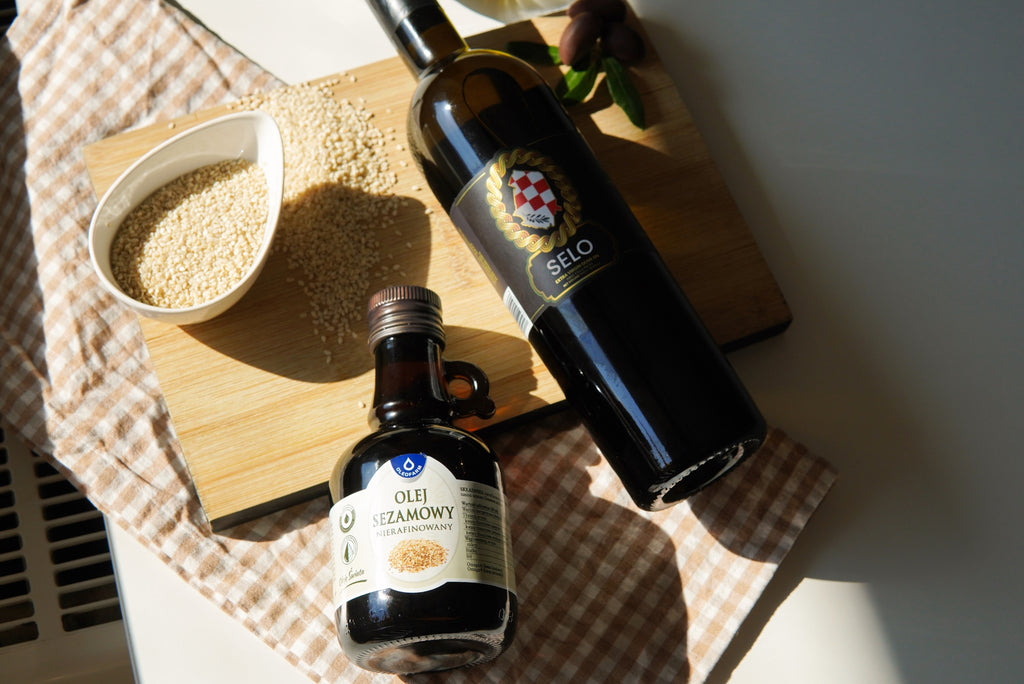Olive oil vs sesame oil is a conundrum that often leaves culinary enthusiasts on the fence. Both oils, derived from their respective plant sources, have carved a niche in kitchens across the globe.
Olive Oil, with its birthplace in the Mediterranean region, has a rich history that dates back thousands of years. Not only does it bring vitality to salads, pastas, and roasted vegetables; it's also part of the very foundation of Mediterranean cuisine. The distinct grassy and peppery undertones make olive oil a versatile player in the culinary world.
On the other hand, Sesame Oil holds an esteemed position in Asian cuisines. Extracted from the tiny sesame seed, this oil boasts an unmistakable nutty flavor that can transform any dish into an exotic delicacy. Whether it's drizzling over salads or adding the finishing touch to stir-fries, sesame oil never fails to leave a memorable imprint on the taste buds.
The decision between olive oil and sesame oil is more than just a matter of flavor- it’s a deep dive into their respective profiles, health benefits, and uses.
Flavor Comparison Between Olive and Sesame Oils
When you dip into the world of culinary oils, you'll find that olive oil and sesame oil have quite distinctive flavors. Each brings its own unique taste to the plate, making them favored in different cuisines worldwide.
Extra virgin olive oil, extracted from fresh olives, offers a medley of flavors. Its taste profile can range from grassy to peppery, buttery to fruity, or even floral - all depending on the varietals of olives used. This distinct flavor diversity is what makes it a beloved ingredient in Mediterranean cuisine. It not only shines in salad dressings and pasta sauces but also works its magic when used for marinating or roasting vegetables.
Now, let's shift our taste buds towards Sesame oil. Originating from sesame seeds, it possesses an earthy, nutty taste. The flavor and aroma are potent and easily recognizable - a characteristic trait that demands careful use. In other words, a little goes a long way with sesame oil. That’s why it’s often used sparingly in diverse Asian cuisines to bring an authentic touch to dishes like stir-fries and salads.
Weaving these oils into your food doesn't just add flavor; they complement and enhance the overall dish too! With olive oil, imagine a rich pasta sauce gaining depth from its fruity undertones. Or consider how a drizzle of sesame oil can elevate an Asian salad with its earthy notes.
A good bottle of extra virgin olive oil can be the secret ingredient adding vibrant layers of flavor to your dishes. This Croatian delight is rich in vitamins and antioxidants - proof that great taste can come hand in hand with health benefits!
So whether you're creating a Mediterranean feast or whipping up an Asian specialty, remember - the choice of oil can make all the difference to your dish's flavor profile!

Health Benefits of Olive and Sesame Oils
Nestling into the heart of the matter, both olive oil and sesame oil boast a plethora of health benefits that warrant their place in your kitchen. Packed with nutritional compounds, these oils are far more than just mere cooking mediums.
Olive oil, adorned for its rich content of monounsaturated fats (specifically oleic acid), is a beacon of health in the Mediterranean diet. Monounsaturated fats are lauded for their heart-healthy properties, aiding in lowering bad cholesterol levels while increasing the good ones. This, in turn, reduces the risk of heart diseases and strokes. But olive oil doesn't stop there. It's also teeming with potent antioxidants like polyphenols which ward off harmful free radicals, keeping oxidative stress and chronic diseases at bay.
In addition to these antioxidants, olive oil is rich in Vitamin E - a fat-soluble nutrient known for its antioxidant capabilities. Vitamin E protects our cells from damage and bolsters immune function, keeping us healthy and robust.
As for sesame oil, it's no less impressive. While it may not have as many nutritional compounds as olive oil, it champions a vital role in our health with its unique blend of poly-unsaturated fats, including omega-3 and omega-6 fatty acids. These essential fats are crucial for brain function, growth, and development. They also help regulate inflammation, blood clotting and can lower cholesterol levels.
So yes, while both oils have different nutritional profiles, they share an underlying theme - they're Healthy Oils that offer immense benefits when incorporated into a balanced diet.
Now let’s dive into another important aspect: smoke points of these oils when faced with the sizzling dance of frying food.
Smoke Points: Olive Oil vs Sesame Oil for Frying
Let's dive into the world of smoke points. This is the temperature at which an oil begins to smoke and break down. Why does it matter, you ask? Well, once an oil reaches its smoke point, not only does it start to lose some of its nutritional value and flavor, but it can also release harmful compounds into your food. So, choosing a cooking oil with a suitable smoke point is crucial when frying.
When we look at olive oil and sesame oil side by side, there's a clear difference in their smoke points. High-quality extra virgin olive oil has a smoke point of about 400 degrees Fahrenheit. On the other hand, unrefined sesame oil lags behind slightly with a lower smoke point of around 350 degrees Fahrenheit.
So what does this mean for your frying adventures? If you're deep frying at home, olive oil would be your best bet due to its higher smoke point. Plus, remember that potent flavor of sesame oil we talked about earlier? It can easily overwhelm your dish if used in large quantities for deep frying. Thus, when it comes to balancing taste and temperature for the best cooking oils for frying, olive oil stands out as the winner.

Environmental Impact and Production of Olive and Sesame Oils
Diving right into the production process, olive oil is produced by crushing olives into a paste, then applying heat and pressure to extract the oil. The remaining pulp, known as pomace, can be repurposed as fertilizer or biofuel — a testament to resourceful utilization. On the other hand, sesame oil extraction involves pressing sesame seeds until they release their natural oils.
However, these processes are not without environmental consequences. For olive oil, a significant amount of water is required during the extraction process. This water usage, coupled with deforestation for olive tree plantation in certain regions, creates an environmental strain. As for sesame oil production, while it uses less water, monoculture farming practices often lead to soil degradation.
Olive oil production:
- Uses significant amounts of water
- May lead to deforestation in certain regions
Sesame Oil Production:
- Lower water usage
- Potential soil degradation due to monoculture practices
Thus, both oils carry a unique set of environmental implications. It's upon us consumers to make informed decisions that align with our environmental consciousness.

Conclusion: Which One Should You Be Using?
The face-off between sesame oil vs olive oil is not about crowning a victor, but understanding their unique strengths. Both oils pack a punch of healthy fats (MUFA and PUFA) and Vitamin E, albeit in varying quantities.
Olive oil, with its wide array of flavors, rich nutrition information, and higher smoke point, fits seamlessly into an expansive range of dishes.
Yet, the distinct nutty flavor of sesame oil holds its own charm, especially in Asian cuisines.
Remember this - your choice should resonate with your culinary style, health goals, and personal taste preferences. So why not explore our premium olive oils or add that bottle of sesame oil to your pantry? Both oils bring something unique to the table!

